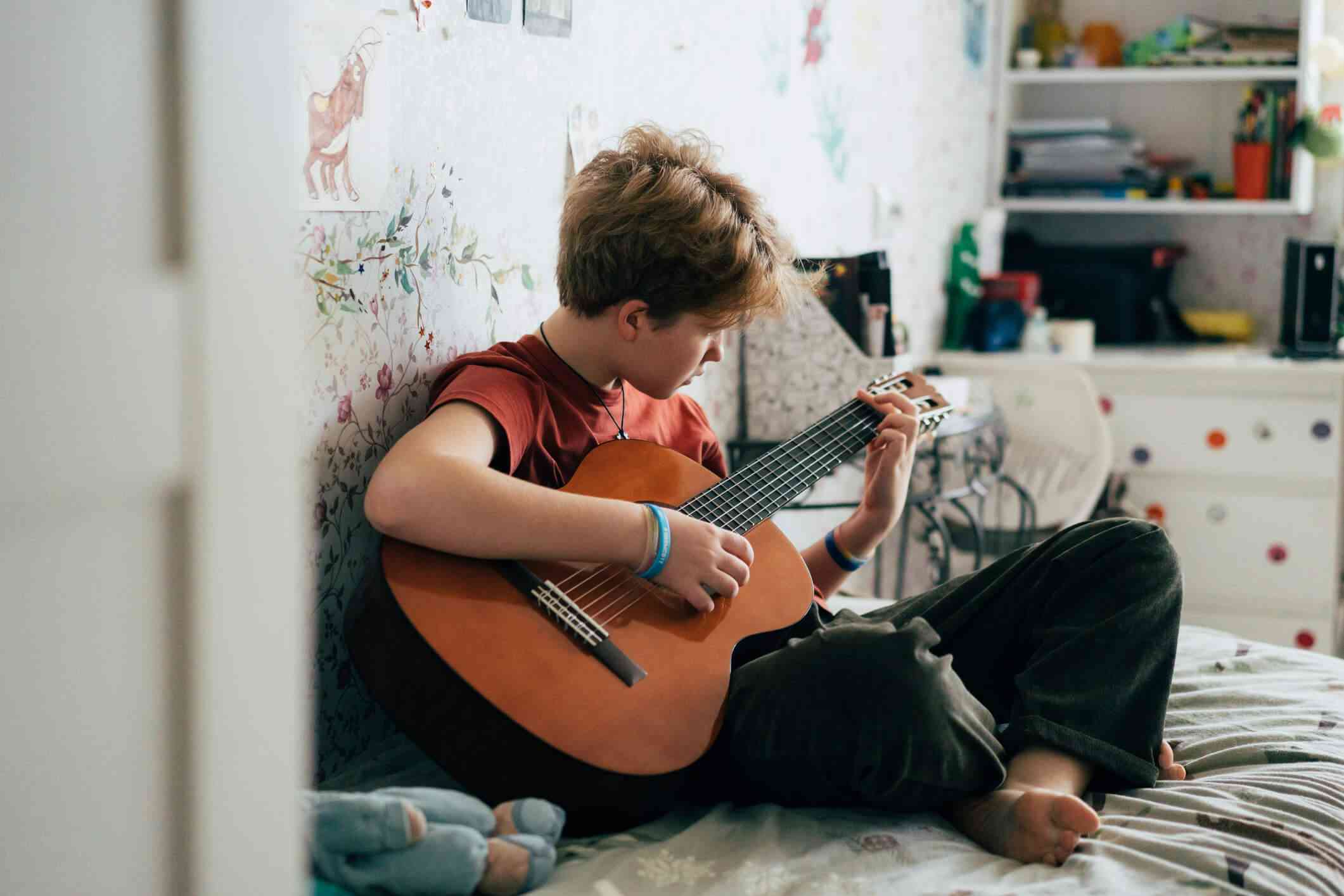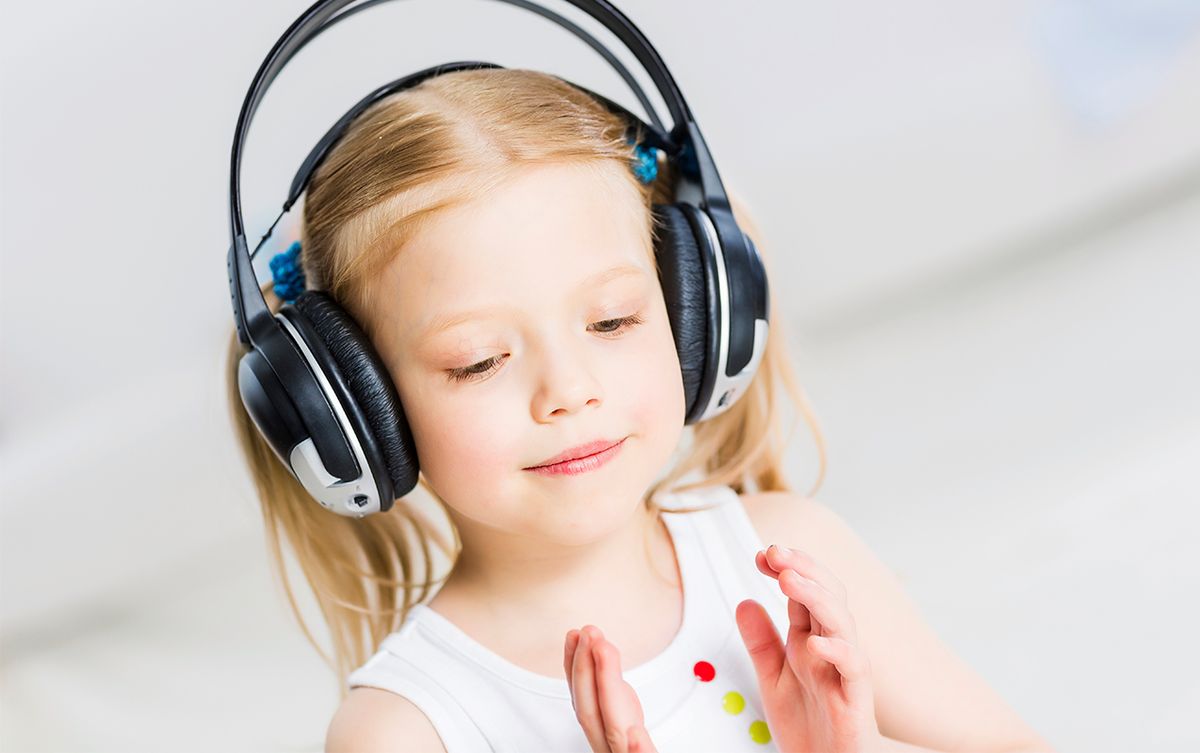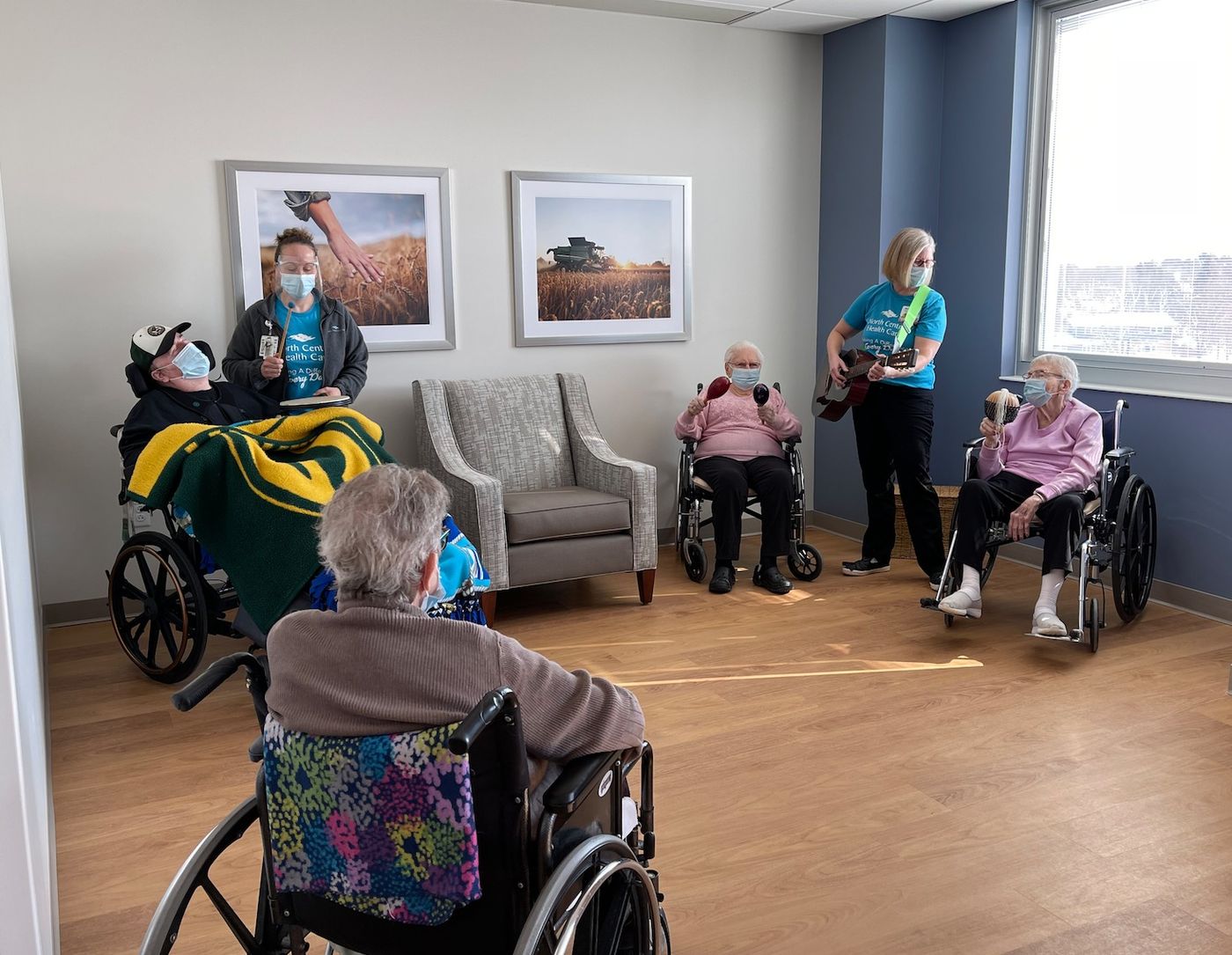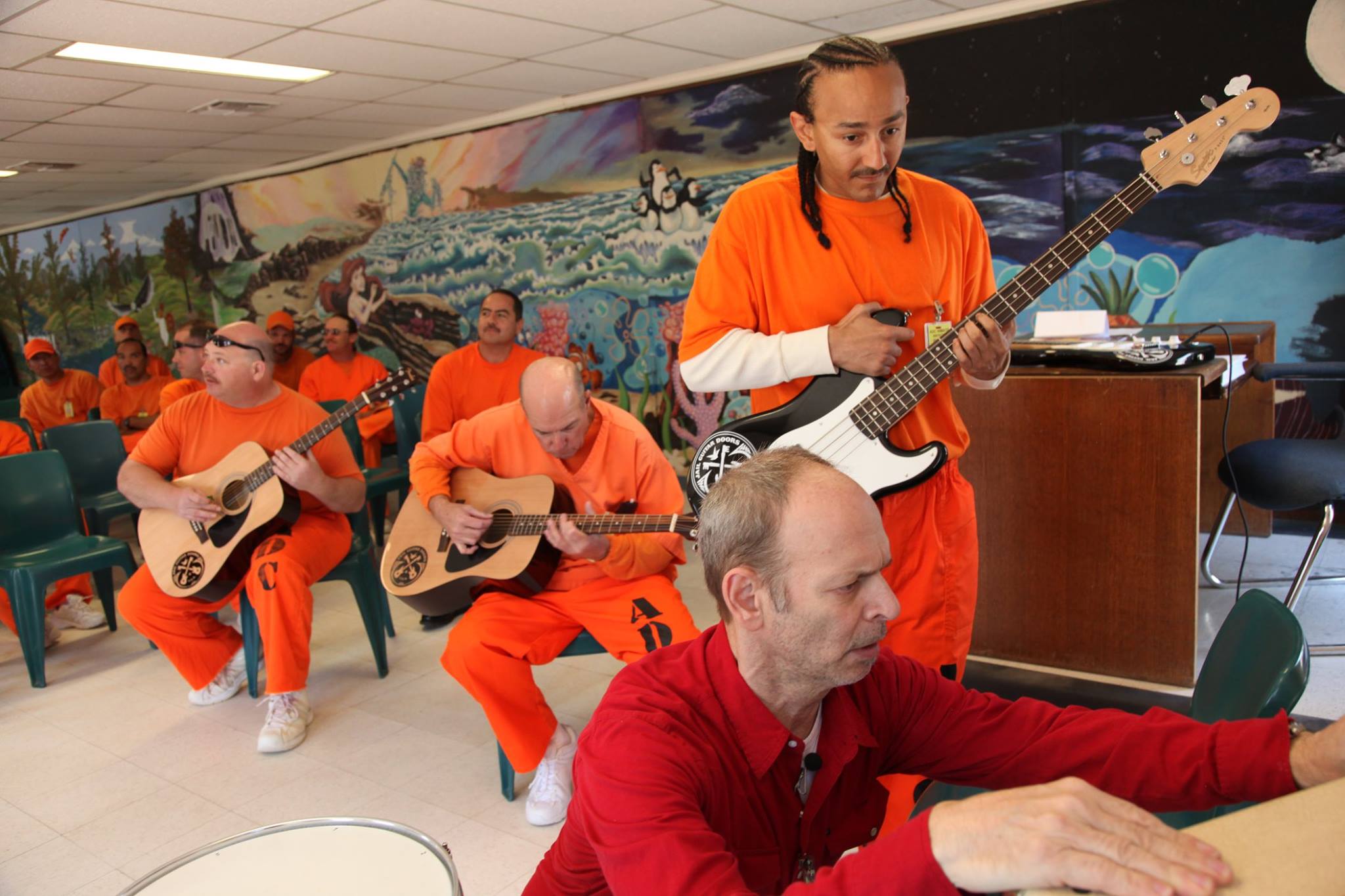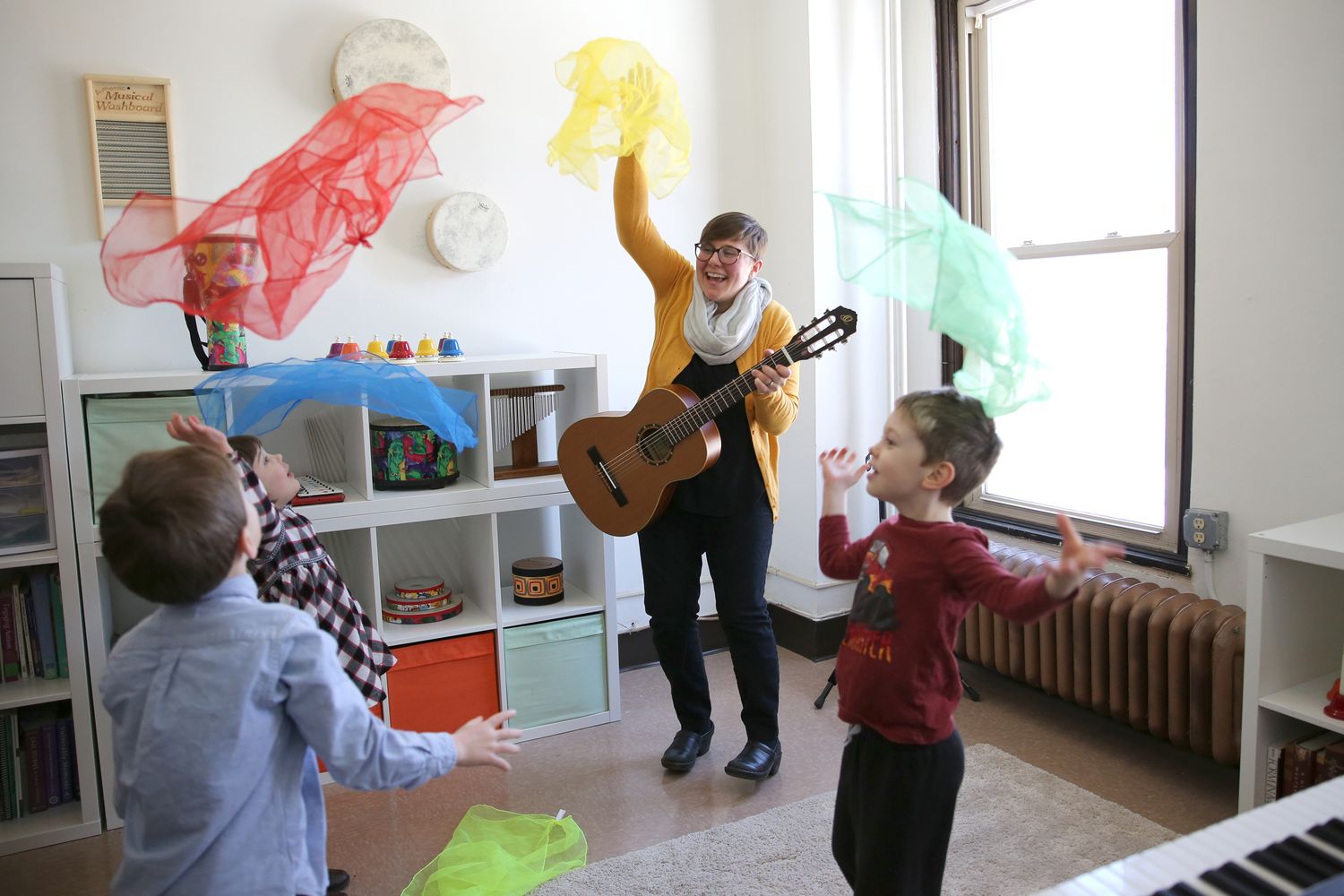Home>Events & Info>Music Therapy>How Are Music Therapy Groups Designed


Music Therapy
How Are Music Therapy Groups Designed
Published: February 2, 2024
Discover the power of music therapy and how it can be effectively utilized in group settings. Explore the design and benefits of music therapy groups.
(Many of the links in this article redirect to a specific reviewed product. Your purchase of these products through affiliate links helps to generate commission for AudioLover.com, at no extra cost. Learn more)
Table of Contents
- Introduction
- Definition of Music Therapy Groups
- The Role of Music in Therapy
- Benefits of Music Therapy Groups
- Factors to Consider in Designing Music Therapy Groups
- Setting Goals for Music Therapy Groups
- Group Size and Composition
- Choosing Music Activities
- Creating a Therapeutic Environment
- Facilitating Group Dynamics
- Evaluating the Effectiveness of Music Therapy Groups
- Conclusion
Introduction
Music has been recognized for centuries as a powerful medium that can profoundly impact our emotions, thoughts, and overall well-being. Music therapy takes this concept a step further by utilizing music as a therapeutic tool to address various physical, emotional, and cognitive challenges. One popular form of music therapy is participating in music therapy groups.
Music therapy groups provide individuals with a structured and supportive environment where they can engage in musical activities to achieve therapeutic goals. These groups are designed and facilitated by trained music therapists who have a deep understanding of the therapeutic potential of music. By harnessing the power of music and the dynamics of group interaction, music therapy groups can be highly effective in promoting growth, healing, and personal development.
In this article, we will explore the various aspects of music therapy groups, including their definition, the role of music in therapy, the benefits they offer, and factors to consider when designing these groups. We will also discuss the importance of setting goals, group size and composition, choosing appropriate music activities, creating a therapeutic environment, facilitating group dynamics, and evaluating their effectiveness.
Whether you are a music therapy enthusiast, a student pursuing a career in music therapy, or someone interested in the healing power of music, this article will provide valuable insights into how music therapy groups are designed and how they can be beneficial for individuals in need of therapeutic support.
Definition of Music Therapy Groups
Music therapy groups are structured sessions led by a trained music therapist, where individuals come together to engage in musical activities for therapeutic purposes. These groups are designed to address a wide range of physical, emotional, cognitive, and social needs by utilizing the transformative power of music.
Unlike individual music therapy sessions, music therapy groups involve multiple participants who interact with each other through music. The group setting allows for shared experiences, support, and mutual growth, fostering a sense of community and connection among the participants.
Music therapy groups can be conducted with various populations, including children, adolescents, adults, and older adults, with each group tailored to meet the specific needs and abilities of the participants. These groups can be found in a variety of settings, such as hospitals, schools, community centers, rehabilitation facilities, and mental health clinics.
The activities conducted in music therapy groups may involve singing, playing musical instruments, listening to music, movement and dance, songwriting, improvisation, and music-guided imagery. The music therapist utilizes these activities to engage the participants and facilitate their expression, communication, emotional processing, self-discovery, and personal growth.
Furthermore, music therapy groups can be designed for specific therapeutic goals, such as improving motor skills, enhancing social interaction, promoting emotional well-being, managing stress and anxiety, boosting self-esteem, enhancing cognitive abilities, and facilitating emotional release and catharsis.
It is important to note that music therapy groups are not music lessons or recreational music activities. While participants may develop musical skills and enjoyment through participation, the primary focus is on the therapeutic benefits of music and the group dynamics that arise during the sessions.
Overall, music therapy groups provide a safe and supportive space for individuals to explore and engage with music in a therapeutic context. Through the guidance and expertise of a music therapist, participants can harness the potential of music to nurture their physical, emotional, and psychological well-being.
The Role of Music in Therapy
Music plays a central role in music therapy groups, as it serves as the primary medium for therapeutic exploration and expression. The unique qualities of music contribute to its effectiveness as a therapeutic tool in several ways:
- Emotional expression: Music has the power to evoke and convey a wide range of emotions. Through music therapy groups, participants can express and process their emotions in a non-verbal and creative manner. By channeling their emotions through music, individuals can experience a sense of release, catharsis, and emotional healing.
- Communication and connection: Music has the ability to transcend language barriers and facilitate communication. In music therapy groups, participants can communicate and connect with others through musical interactions, even if they struggle with verbal communication. This can foster a sense of belonging, support, and understanding within the group.
- Motivation and engagement: Music has an inherent ability to captivate and engage individuals. In music therapy groups, participants are often more motivated to participate and actively engage in therapeutic activities when music is involved. The rhythmic and melodic elements of music can enhance focus, attention, and participation.
- Sensory stimulation: Music provides a multi-sensory experience, engaging auditory, visual, and tactile senses. This sensory stimulation can have a positive impact on various aspects of cognitive functioning, such as attention, memory, and sensory integration. Additionally, the rhythmic qualities of music can support physical coordination and motor skills development.
- Mood regulation: Music has the ability to influence and modulate mood. Upbeat and uplifting music can promote feelings of joy, relaxation, and motivation, while slower and soothing music can induce a sense of calmness and relaxation. Music therapy groups utilize music to help regulate participants’ emotions and create a supportive and positive atmosphere.
The therapeutic qualities of music are harnessed by music therapists in various ways within music therapy groups. The music therapist carefully selects and designs music activities that align with the therapeutic goals of the group. These activities may involve listening to music, playing instruments, singing, improvising, composing, and movement to music. The therapist’s expertise in music and its therapeutic applications allows them to create a safe and nurturing environment where participants can explore, express, and heal through music.
In summary, music in therapy groups acts as a powerful catalyst for emotional expression, communication, motivation, sensory stimulation, mood regulation, and therapeutic growth. By harnessing the unique qualities of music, music therapy groups offer a transformative and holistic approach to healing and personal development.
Benefits of Music Therapy Groups
Music therapy groups offer a wide range of benefits to individuals who participate in them. These benefits extend to various aspects of physical, emotional, cognitive, and social well-being. Here are some of the key benefits of music therapy groups:
- Emotional expression and regulation: Music therapy groups provide a safe and supportive space for participants to express and process their emotions. Through music, individuals can communicate and explore their feelings, leading to greater emotional awareness and regulation.
- Social interaction and connection: Music therapy groups foster social interaction and connection among participants. The collaborative nature of musical activities promotes communication, cooperation, and a sense of belonging. This can be particularly beneficial for individuals who struggle with social skills or feel isolated.
- Improved communication skills: Music therapy groups can enhance communication skills, including verbal and non-verbal communication. The use of music as a medium allows participants to express themselves in a different way, building confidence and improving overall communication abilities.
- Enhanced cognitive abilities: Participating in music therapy groups can have positive effects on cognitive functioning. The structured nature of music activities can improve attention, memory, and problem-solving skills. Moreover, the rhythmic and melodic components of music can support cognitive processing and coordination.
- Stress and anxiety reduction: Listening to soothing music, engaging in relaxation techniques, and participating in musical activities can help reduce stress and anxiety. The therapeutic nature of music promotes relaxation, emotional release, and a sense of calmness.
- Pain and symptom management: Music therapy groups can offer support in managing physical pain and discomfort. Music has been shown to help alleviate pain, decrease muscle tension, and improve overall well-being.
- Self-expression and creativity: Music therapy groups provide a creative outlet for self-expression. Participants can explore their creativity, write songs, improvise, or play musical instruments. This process encourages self-discovery, boosts self-esteem, and promotes a sense of personal fulfillment.
- Positive mood and well-being: Engaging in music therapy groups can elevate mood, promote a sense of happiness, and enhance overall well-being. Music has the power to evoke positive emotions, and when combined with group dynamics and support, it can have a profound effect on participants’ emotional state.
These are just a few of the many benefits that music therapy groups can offer. The therapeutic environment, guided by a skilled music therapist, allows participants to experience growth, healing, and personal development through the power of music and group interaction.
It is important to note that the specific benefits experienced by individuals may vary depending on their unique needs, goals, and abilities. Music therapy is a highly individualized approach, and the music therapist works closely with each participant to tailor the activities and interventions to their specific needs and goals.
Factors to Consider in Designing Music Therapy Groups
When designing music therapy groups, several factors need to be taken into consideration to ensure that the sessions are effective, engaging, and tailored to the participants’ needs. Here are some key factors to consider:
- Goals and objectives: Clearly define the goals and objectives of the music therapy group. These goals may pertain to specific areas such as emotional expression, social interaction, cognitive development, or physical rehabilitation. Design the activities and interventions in alignment with these goals to ensure that the group sessions are focused and purposeful.
- Group size and composition: Determine the optimal group size based on the therapeutic goals and individual needs of the participants. Consider factors such as the level of interaction required, the comfort level of group members, and the dynamics that will contribute to a supportive and cohesive group environment. Strive for a balance between having enough participants for social interaction and avoiding overcrowding that may hinder individual attention and engagement.
- Age and developmental stage: Take into account the age and developmental stage of the participants when designing music therapy groups. Consider age-appropriate musical activities, communication styles, and cognitive abilities. Adapt the interventions to meet the specific needs and interests of different age groups, whether it’s children, adolescents, adults, or older adults.
- Adaptability and flexibility: Music therapy groups should allow for adaptability and flexibility to meet the changing needs of the participants. Be prepared to modify activities, pacing, and interventions based on individual responses and group dynamics. This flexibility ensures that the sessions remain engaging, motivating, and responsive to each participant’s unique progress and goals.
- Cultural sensitivity: Consider the cultural backgrounds, preferences, and values of the participants. Incorporate music from various cultures or allow participants to share and contribute music that is meaningful to them. Respect cultural differences and ensure that the chosen music activities are inclusive and sensitive to the diverse backgrounds of the participants.
- Accessibility and inclusion: Create an inclusive environment that accommodates individuals with diverse abilities and needs. Ensure that the physical layout of the space allows for easy accessibility and that the musical instruments and materials are adapted or modified as necessary for participants with physical, sensory, or cognitive challenges.
- Therapist expertise: The music therapist’s expertise and training play a crucial role in designing effective music therapy groups. The therapist should have a deep understanding of music therapy principles, interventions, and techniques to address various therapeutic goals. Additionally, ongoing professional development and staying abreast of current research and best practices are essential for quality and efficacy.
- Ethics and professional guidelines: Adhere to the ethical guidelines and professional standards set by the music therapy profession. Respect confidentiality, informed consent, and the rights and autonomy of the participants. Ensure the safety and well-being of all individuals involved in the music therapy group sessions.
By considering these factors in the design of music therapy groups, therapists can create an enriching and therapeutic experience that supports the participants’ growth, development, and well-being.
Setting Goals for Music Therapy Groups
Setting clear and measurable goals is an essential component of designing effective music therapy groups. Goals provide a framework and direction for the group sessions, guiding the selection of appropriate interventions and activities. When setting goals for music therapy groups, it is important to consider the following factors:
- Individual needs: Each participant in the group may have unique needs, challenges, and aspirations. The goals should address those individual needs while also considering the dynamics and goals of the group as a whole. Conduct individual assessments or interviews to understand the participants’ goals, interests, strengths, and areas for growth.
- Therapeutic focus: Determine the therapeutic focus of the music therapy group. This could include emotional expression and regulation, social skill development, cognitive rehabilitation, stress reduction, pain management, or any other specific therapeutic area. The goals should align with the desired outcomes in the chosen therapeutic focus.
- S-M-A-R-T framework: Use the S-M-A-R-T framework to ensure that goals are specific, measurable, achievable, relevant, and time-bound. Specific goals provide clarity and precision, measurable goals allow for objective evaluation, achievable goals are realistic and attainable, relevant goals relate directly to the therapeutic focus, and time-bound goals have a clear timeline for completion.
- Short-term and long-term goals: Set both short-term and long-term goals to provide a sense of progression and accomplishment. Short-term goals serve as stepping stones towards the long-term goals and offer immediate feedback and motivation. Long-term goals reflect broader outcomes that participants aim to achieve during their engagement in the group.
- Collaboration with participants: Involve participants in the goal-setting process to ensure ownership and motivation. Seek their input, preferences, and aspirations, and work together to establish goals that are meaningful and relevant to them. This collaborative approach empowers participants and enhances their engagement and commitment to the therapy process.
- Assessment and reassessment: Regularly assess and reassess the participants’ progress towards the goals. Modify or adjust goals as needed based on individual responses, changes in needs, or the evolving dynamics of the group. This ongoing assessment allows for personalized interventions and ensures that the goals remain relevant and achievable.
- Documentation and communication: Document the goals and progress of each participant and maintain open communication with them and any relevant stakeholders (e.g., caregivers, healthcare professionals). This documentation promotes accountability, continuity of care, and facilitates collaborative decision-making regarding the treatment and goals.
Setting goals for music therapy groups not only provides a sense of direction and purpose but also allows the therapist to evaluate the effectiveness of the interventions and track the participants’ progress. Goals serve as a roadmap towards achieving the desired therapeutic outcomes and contribute to the holistic growth and development of the individuals within the group.
Group Size and Composition
The size and composition of a music therapy group are critical factors that can significantly impact the effectiveness and dynamics of the sessions. When determining the group size and composition, it is important to consider the following factors:
- Therapeutic goals: Consider the therapeutic goals of the group when determining the appropriate size. Smaller groups may be more suitable for activities that require individual attention and focused interaction, while larger groups can facilitate social interaction and community building.
- Interaction level: The desired level of interaction among participants should be taken into account. Smaller groups often allow for more intimate and detailed interactions among the participants and the therapist. In contrast, larger groups can foster group dynamics and opportunities for socialization and shared experiences.
- Individual attention: Consider the need for individual attention and support. Smaller groups may allow the therapist to provide more one-on-one guidance and support to each participant, addressing their specific needs. This can be particularly important when working with individuals who require additional support or have more complex needs.
- Group dynamics: The dynamics and balance within the group should be considered. Strive for a composition that promotes inclusivity, mutual respect, and cohesive group dynamics. Pay attention to factors such as age, developmental stage, cultural background, and compatibility of participants’ needs and goals.
- Group cohesion: Cohesion within the group is vital for fostering a supportive and connected environment. Assess the participants’ ability to work together, communicate, and support one another. It is essential to create a sense of safety and trust within the group to facilitate open expression and exploration.
- Potential for parallel activities: Consider the need for parallel activities within the group sessions. In some cases, participants may benefit from engaging in different activities or interventions simultaneously based on their individual goals or abilities. Appropriate group size and composition can accommodate the possibility of parallel activities to meet individual needs.
- Space and resources: Ensure that the physical space and available resources can accommodate the chosen group size. Having enough space for participants to comfortably engage in musical activities and providing sufficient instruments and materials for everyone are essential for a successful group experience.
Ultimately, there is no one-size-fits-all approach to determining the ideal group size and composition for music therapy. It depends on the goals, dynamics, and individual needs of the participants. Flexibility is key, as group composition and dynamics may evolve over time, requiring adjustments to meet the changing needs of the participants.
Music therapists should carefully consider these factors and use their professional judgment to create a therapeutic environment that maximizes the potential for growth, interaction, and meaningful engagement within the music therapy group.
Choosing Music Activities
The selection of appropriate music activities is a crucial aspect of designing effective music therapy groups. The chosen activities should align with the therapeutic goals, engage the participants, and facilitate their growth and development. When choosing music activities for a therapy group, the following factors should be taken into consideration:
- Therapeutic goals: Consider the specific therapeutic goals of the group when selecting music activities. Different activities can target various areas, such as emotional expression, social interaction, cognitive development, or physical rehabilitation. The activities should be chosen with the intention of achieving desired therapeutic outcomes.
- Individual needs and preferences: Tailor the music activities to meet the individual needs, abilities, and preferences of the participants. Take into account their musical background, interests, and any specific challenges or strengths they may have. Offering choices and incorporating participants’ personal preferences can enhance their engagement and motivation.
- Musical elements: Consider the specific musical elements that can contribute to achieving the therapeutic goals. Elements such as rhythm, melody, harmony, tempo, and dynamics can be utilized to evoke certain emotional responses, promote relaxation, or facilitate cognitive engagement. Select activities that highlight these elements in a meaningful way.
- Accessibility: Ensure that the chosen music activities are accessible and suitable for all participants. Consider participants with diverse abilities, including those with physical, sensory, or cognitive challenges. Adapt or modify activities as needed to ensure inclusion and participation by all group members.
- Developmental appropriateness: Adapt the activities to be developmentally appropriate for the age and cognitive abilities of the participants. Use music activities that are engaging and stimulating, yet within their skill level. This allows participants to experience success and progress, building their confidence and motivation.
- Varied modalities: Incorporate a variety of musical modalities into the group activities. This may include singing, playing musical instruments, movement to music, improvisation, music-guided imagery, songwriting, or music listening. Diversifying the types of activities offers participants different ways of engaging with music and can cater to their unique strengths and interests.
- Group dynamics: Consider how the selected activities will foster group dynamics and interaction. Some activities may encourage collaboration, turn-taking, or shared musical experiences, while others may promote individual expression and reflection. Strive for a balance between creating opportunities for individual growth and nurturing a sense of community within the group.
- Progression and variety: Plan for a progression of activities that gradually increase in complexity or challenge, allowing the group to build upon skills and experiences. Introduce a variety of activities to keep the sessions engaging and fresh. Providing a mix of familiar and new activities can maintain interest and cater to the diverse preferences of the participants.
The music therapist’s expertise and knowledge of music therapy techniques and interventions play a crucial role in selecting appropriate music activities. They should carefully assess the individual and group dynamics and make informed decisions to create a tailored and effective approach that meets the therapeutic goals and engages the participants.
Regular evaluation and feedback from the participants can also guide the selection of music activities, as their responses and preferences can inform adjustments or modifications to enhance the therapeutic experience.
Creating a Therapeutic Environment
Creating a therapeutic environment is essential in music therapy groups as it sets the tone for emotional safety, creativity, and growth. A therapeutic environment nurtures a sense of trust, openness, and connection among the participants. When establishing the environment, consider the following factors:
- Physical space: Create a space that is comfortable, inviting, and conducive to musical activities. Ensure that the physical layout allows for easy movement, instrument accessibility, and visibility. Arrange the space in a way that promotes interaction, while also providing options for privacy or personal space when needed.
- Safety and confidentiality: Establish an atmosphere that promotes emotional and physical safety. Emphasize the importance of confidentiality, encouraging participants to share and express themselves without fear of judgment or disclosure. Make it clear that their privacy and personal information will be respected and protected.
- Warmth and acceptance: Foster an environment of warmth, acceptance, and non-judgment. Show genuine interest, empathy, and respect for each participant, creating a space where they feel valued and heard. The therapist’s attitude and presence play a crucial role in cultivating a supportive and inclusive atmosphere.
- Clear expectations and boundaries: Set clear expectations and establish guidelines to ensure that the group operates in a respectful and harmonious manner. Communicate and reinforce the boundaries of appropriate behavior, confidentiality, and respect for one another. This establishes a sense of structure and predictability, contributing to a safe therapeutic environment.
- Positive reinforcement: Incorporate positive reinforcement and encouragement into the group dynamic. Recognize and celebrate the achievements, efforts, and growth of the participants. This fosters a sense of validation, builds self-esteem, and motivates continued engagement and progress within the group.
- Emotional support: Create an environment that offers emotional support and validation. Encourage participants to express their thoughts, feelings, and concerns, and respond with empathy and compassion. This validation fosters trust, catharsis, and emotional healing within the group context.
- Cultural sensitivity: Be sensitive to the diverse cultural backgrounds and values of the participants. Incorporate culturally inclusive practices, music, and activities that respect and honor the participants’ heritage and preferences. Create an environment that allows participants from different cultural backgrounds to feel comfortable and included.
- Flexibility and adaptability: Remain flexible and adaptable to the changing needs and dynamics of the group. Adjust the environment and interventions as necessary to meet the evolving goals and individual requirements. Being responsive to the participants’ progress and feedback creates a tailored and effective therapeutic environment.
A therapeutic environment in music therapy groups provides the foundation for participants to explore, express, and heal through music. The music therapist plays a crucial role in cultivating this environment, using their skills, presence, and expertise to create a safe, nurturing, and transformative space for growth and personal development.
Facilitating Group Dynamics
Facilitating group dynamics is an integral part of music therapy groups. Group dynamics refer to the interactions, relationships, and communication patterns that emerge within the group. As a music therapist, it is essential to understand and skillfully manage these dynamics to create a supportive and productive therapeutic environment. Here are some key considerations when facilitating group dynamics:
- Establishing rapport: Build rapport with the participants and foster positive relationships among group members. Create a sense of trust and connection by actively listening, demonstrating empathy, and consistently showing respect and support.
- Encouraging participation: Encourage active participation from all group members. Create opportunities for everyone to contribute and validate their contributions. Be mindful of different communication styles and adapt your approaches to ensure that all voices are heard and valued.
- Promoting active listening: Emphasize the importance of active listening within the group. Encourage participants to listen attentively to one another and respond thoughtfully. Incorporate activities that develop listening skills, such as call-and-response exercises or partner improvisations.
- Managing conflicts: Address conflicts or tensions that may arise within the group promptly and constructively. Create a safe space for participants to express their concerns and work towards resolution. Utilize music as a tool for emotional expression and facilitate open communication to foster understanding and empathy.
- Fostering collaboration: Create opportunities for collaboration and joint musical experiences within the group. Collaborative activities, such as creating a group composition or performing together, encourage cooperation, shared decision-making, and a sense of cohesion.
- Encouraging reflection and feedback: Incorporate regular reflection and feedback sessions to encourage participants to share their thoughts, feelings, and experiences. This provides an opportunity to further explore the therapeutic process, address any concerns, and gather insights for personal growth.
- Addressing power dynamics: Be mindful of power dynamics that may emerge within the group. Ensure equal opportunities for participation and decision-making. Actively challenge any dynamics that may marginalize or silence certain individuals, promoting inclusivity and equity within the group.
- Celebrating achievements: Celebrate individual and group achievements. Recognize and affirm the progress, effort, and growth of the participants. This nurtures a sense of accomplishment, boosts self-esteem, and reinforces the therapeutic goals of the group.
As a music therapist, your role is to guide and facilitate group dynamics, allowing participants to draw from and contribute to the collective therapeutic experience. By fostering a safe and supportive environment, promoting active participation, and addressing conflicts with care and empathy, you can create a space where group members can develop meaningful connections, explore personal growth, and develop valuable life skills.
Evaluating the Effectiveness of Music Therapy Groups
Evaluating the effectiveness of music therapy groups is an essential part of ensuring that the therapeutic goals are being met and that the participants are benefiting from the sessions. Evaluation provides valuable insights that help guide and improve the group process. Here are some key considerations for evaluating the effectiveness of music therapy groups:
- Goal attainment: Assess the extent to which the goals set for the group have been achieved. Compare the progress made by participants at the beginning of the group to their current status. Take into account both objective measures, such as changes in skill development or behavior, as well as subjective measures, such as self-reported improvements in well-being or satisfaction.
- Participant feedback: Gather feedback from the participants regarding their experience in the group. This can be done through verbal discussions, written surveys, or individual interviews. Ask them about their perceptions of the group, the activities, and any changes they have noticed. Their feedback provides valuable insights into the subjective experiences and outcomes of the group.
- Therapist observation: The music therapist’s observations and reflections are a crucial component of evaluating the group’s effectiveness. The therapist should document observations regarding participants’ engagement, emotional responses, interpersonal dynamics, and progress towards goals. These observations can inform adjustments to the interventions, activities, or group structure as needed.
- Measuring outcomes: Implement pre- and post-group assessments to quantify changes in specific areas targeted by the therapy. Use standardized assessment tools, questionnaires, or inventories to measure changes in areas such as emotional well-being, social functioning, cognitive skills, or physical rehabilitation. This provides objective data to support the evaluation of the group’s effectiveness.
- Comparative analysis: Compare the outcomes of the current group with previous similar groups or established research findings. This can help identify trends, benchmarks, or common themes that contribute to effectiveness. Comparing outcomes across different groups allows for insights into best practices and areas for improvement.
- Interdisciplinary collaboration: Collaborate with other professionals, such as psychologists, educators, or healthcare providers, to gather additional perspectives on the participants’ progress and well-being. Their input can provide a holistic view of the impact of the music therapy group in relation to other interventions or therapies.
- Long-term follow-up: Consider conducting long-term follow-up assessments to determine the sustainability of the effects of the music therapy group. Follow up with participants after the group has concluded to assess the durability of the therapeutic outcomes and identify any areas that may require ongoing support or intervention.
Evaluation should be an ongoing and integral part of the music therapy group process. It allows for continuous improvement and ensures that the group is meeting the needs of the participants. By combining various evaluation methods, including participant feedback, therapist observation, standardized assessments, and interdisciplinary collaboration, the effectiveness of the music therapy group can be assessed comprehensively, leading to informed decision-making and enhanced therapeutic outcomes.
Conclusion
Music therapy groups provide a powerful platform for healing, growth, and self-expression through the therapeutic use of music and group dynamics. These groups, guided by skilled music therapists, offer a safe and supportive environment for individuals to explore their emotions, enhance social interaction, develop cognitive skills, and promote overall well-being.
In this article, we have explored the various aspects of music therapy groups, including their definition, the role of music in therapy, the benefits they offer, and the factors to consider when designing and facilitating these groups. We have discussed the importance of setting goals that align with the participants’ needs and therapeutic focus, considering group size and composition, and selecting appropriate music activities that cater to individual preferences and abilities.
Creating a therapeutic environment that prioritizes safety, warmth, and acceptance is crucial for fostering meaningful connections and emotional exploration within the group setting. Facilitating group dynamics involves nurturing collaboration, addressing conflicts constructively, and encouraging active participation and reflection among participants.
Effectively evaluating the outcomes of music therapy groups ensures that the therapeutic goals are being met and provides opportunities for improvement and growth. By collecting participant feedback, conducting pre- and post-group assessments, and collaborating with other professionals, we can gain valuable insights into the effectiveness and sustainability of these interventions.
In conclusion, music therapy groups offer a transformative and holistic approach to therapy, utilizing the power of music and group dynamics to enhance emotional well-being, social interaction, cognitive skills, and overall quality of life. With its unique ability to transcend language and touch the soul, music provides a therapeutic medium that can unlock the potential for healing, expression, and personal growth within individuals and the group as a whole.





